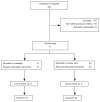Massage therapy and labor outcomes: a randomized controlled trial
- PMID: 23429706
- PMCID: PMC3528187
- DOI: 10.3822/ijtmb.v5i4.164
Massage therapy and labor outcomes: a randomized controlled trial
Erratum in
- Int J Ther Massage Bodywork. 2013;6(1):25
Abstract
Introduction: Massage is a time-honored method by which women have received comfort throughout the millennia, yet it has not been rigorously evaluated in the modern day delivery suite. No study to date that we are aware of has evaluated the effect of massage therapy by a regulated massage therapist on labor pain. The purpose of this study was to evaluate the effectiveness of massage therapy provided by registered massage therapists in managing pain among women in active labor.
Methods: BC Women's Hospital, Vancouver, BC.
Research design: a randomized controlled trial.
Participants: 77 healthy nulliparous women presenting in spontaneous labor.
Intervention: Swedish massage administered for up to five hours by a registered massage therapist during labor vs. standard care. Main outcome measures include: cervical dilation at the time of administration of epidural, compared using estimated marginal means in an analysis of covariance. We also compared perception of pain at three time periods during labor according to cervical dilation at 3-4 cm, 5-7 cm, and 8-10 cm using the McGill Present Pain Intensity Scale.
Results: The mean cervical dilation at the time of epidural insertion after adjustment for station of the presenting part, cervical dilation, and status of membranes on admission to hospital was 5.9 cm (95% CI 5.2-6.7) compared to 4.9 in the control group (95% CI 4.2-5.8). Scores on the McGill Pain Scale were consistently lower in the massage therapy group (13.3 vs. 16.9 at 3-4 cm, 13.3 vs. 15.8 at 5-6 cm, and 19.4 vs. 28.3 at 7-8 cm), although these differences were not statistically significant.
Conclusions: Our findings from this pilot study suggest that massage therapy by a registered massage therapist has the potential to be an effective means of pain management that may be associated with delayed use of epidural analgesia. It may therefore have the potential to reduce exposure to epidural analgesia during labor and decrease rates of associated sequelae.
Keywords: epidural analgesia; labor pain; massage; randomized controlled trial.
Figures
References
-
- Elston D, Stanley G, Burrows G. Psychological Control of Pain. New York: Grune & Stratton; 1983.
-
- Declercq E, Sakala C, Corry M, et al. Listening to Mothers II: Report of the Second National US survey of women’s childbearing experiences. New York: Childbirth Connection; 2006.
-
- Brar S, Tang S, Drummond N, et al. Perinatal care for South Asian immigrant women and women born in Canada: telephone survey of users. J Obstet Gynaecol Can. 2009;31(8):708–16. - PubMed
LinkOut - more resources
Full Text Sources
Medical

